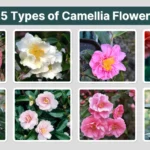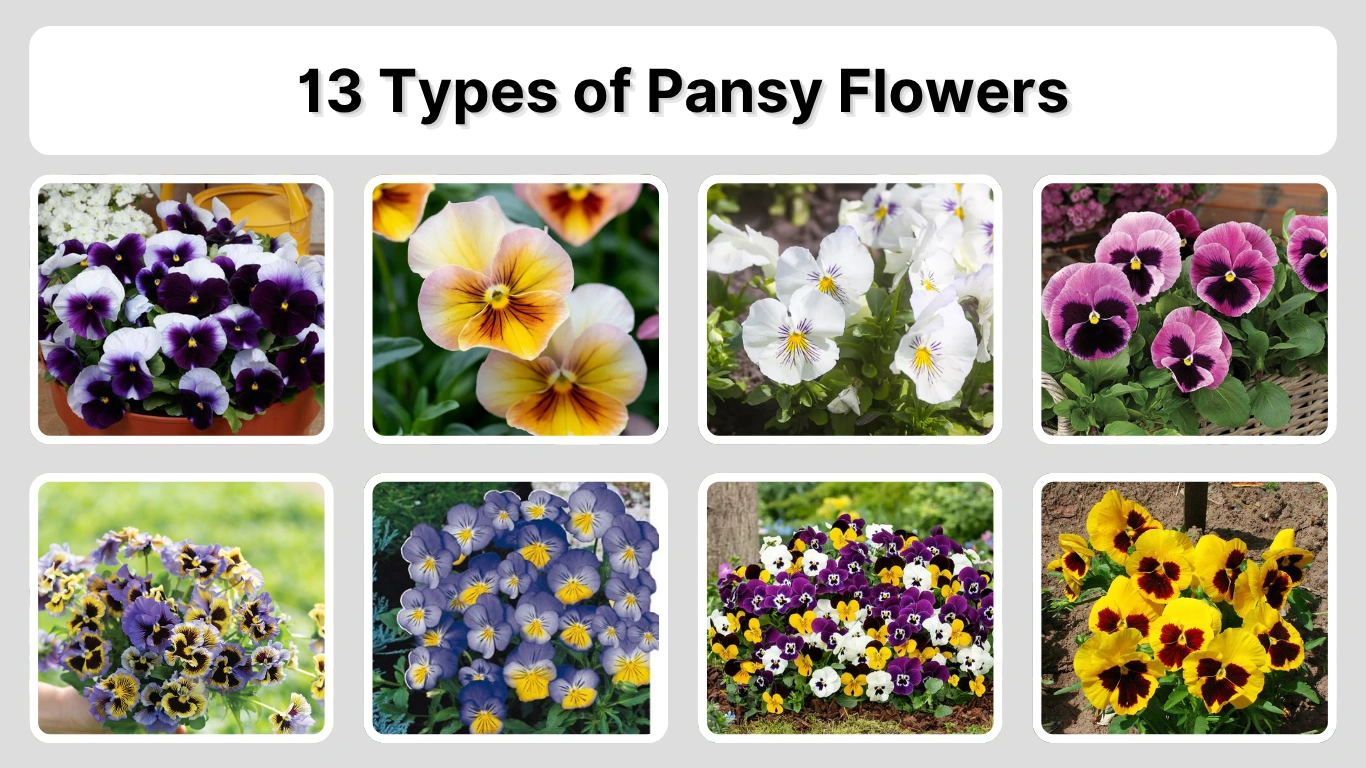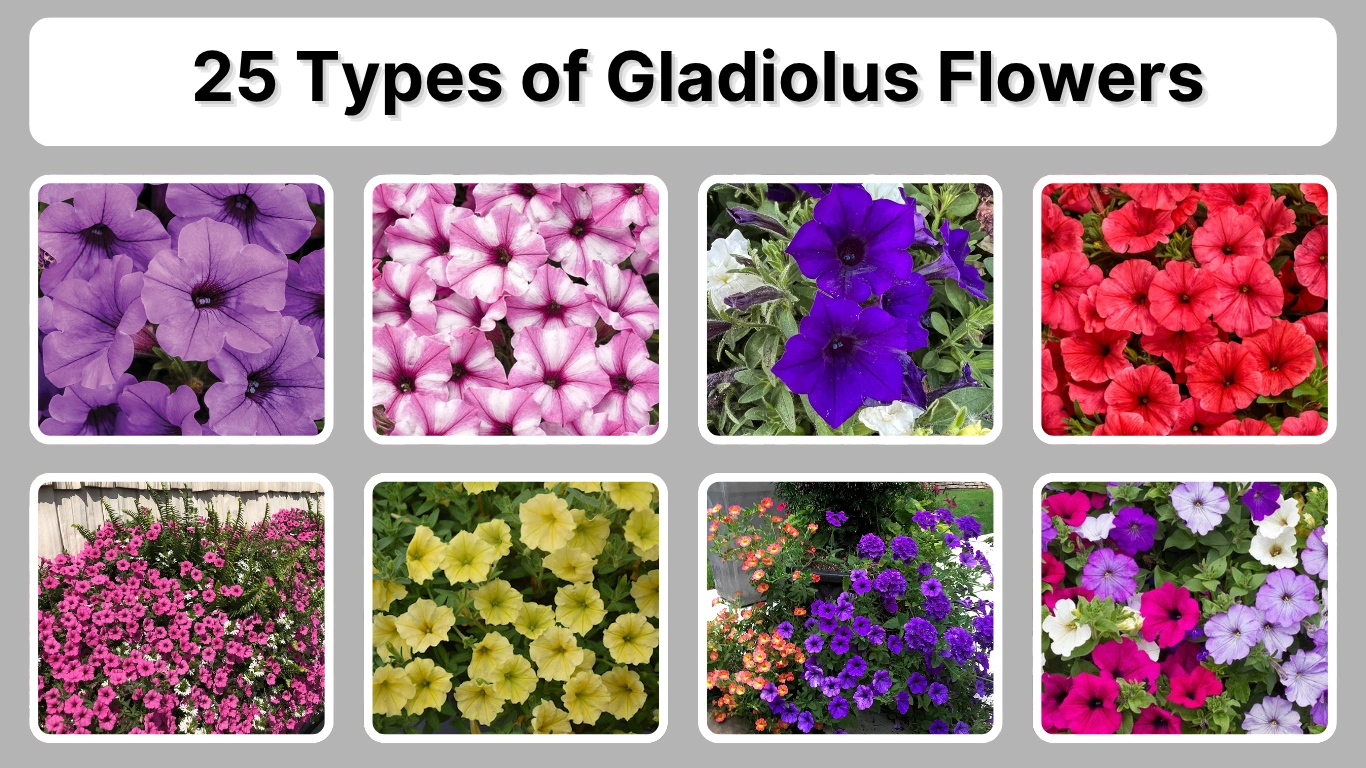Camellias are timeless flowering shrubs that bring refined beauty to gardens with their glossy evergreen leaves and exquisite blooms. From the vibrant reds and pure whites of Camellia japonica to the fall-flowering charm of Camellia sasanqua and rare hybrids with fragrant or dark-toned petals, these plants offer exceptional diversity. Whether you’re designing a formal landscape, adding winter interest, or creating a shaded retreat, camellias provide blooms from autumn to spring. This curated list of 25 popular and unique camellia varieties will help you discover the best options for color, form, fragrance, and seasonal appeal in any garden setting.
1. Camellia japonica
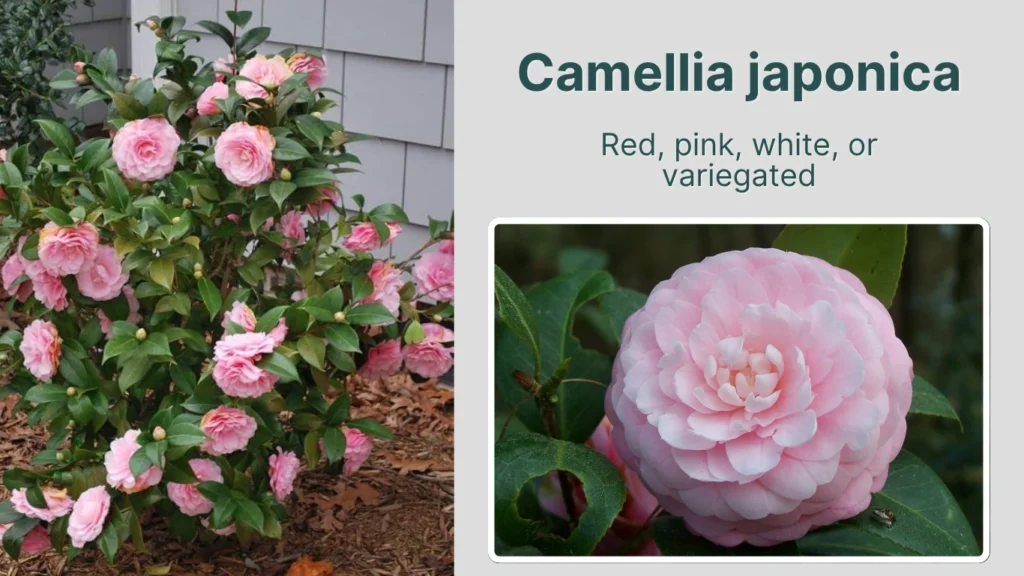
Camellia japonica is the most iconic and widely cultivated species of camellia, celebrated for its large, rose-like blooms and glossy evergreen leaves. It blooms in late winter to early spring and is a classic favorite in shaded gardens and woodland settings.
Identification
- Flower Color: Red, pink, white, or variegated
- Bloom Form: Single, semi-double, or fully double
- Leaf Type: Glossy, dark green, oval with serrated edges
- Height: 6–12 feet (can grow taller if unpruned)
- Bloom Time: Late winter to early spring
- Type: Evergreen flowering shrub
Origin and Popularity
Native to Japan, Korea, and China, Camellia japonica has been cultivated for centuries and is prized for its beauty, longevity, and symbolic meaning. It’s often featured in traditional Japanese gardens, historic southern U.S. landscapes, and botanical collections worldwide.
Growing and Blooming Season
Plant in fall or early spring. Blooms begin in late winter and continue into spring. Best grown in USDA zones 7–9. Prefers partial shade and well-drained, acidic soil. It requires protection from harsh afternoon sun and strong winds.
Companion Plants
Perfect alongside azaleas, rhododendrons, ferns, and hostas. The deep green foliage makes a great backdrop for spring bulbs, and the flowers add elegance to shaded garden borders or woodland paths.
2. Camellia sasanqua

Camellia sasanqua is a graceful, early-blooming camellia species known for its smaller, fragrant flowers and more open, arching growth. It’s ideal for hedges, espalier, or mixed borders and adds delicate beauty to autumn and early winter gardens.
Identification
- Flower Color: White, pink, red, or bi-colored
- Bloom Form: Single or semi-double
- Leaf Type: Small, dark green, glossy, and pointed
- Height: 6–10 feet
- Bloom Time: Fall to early winter
- Type: Evergreen flowering shrub
Origin and Popularity
Native to Japan, Camellia sasanqua has become a staple in southern gardens due to its adaptability and earlier bloom time. It is prized for its light fragrance, versatility in landscape use, and ability to thrive in full sun better than other camellia types.
Growing and Blooming Season
Plant in spring or fall. Blooms begin in late autumn and last through early winter. Hardy in USDA zones 7–10. Prefers slightly acidic, well-drained soil and grows well in both full sun and partial shade.
Companion Plants
Blends well with gardenias, loropetalum, boxwood, and ornamental grasses. Its compact habit also pairs nicely with pansies, violas, and cool-season annuals near the base.
3. Camellia reticulata
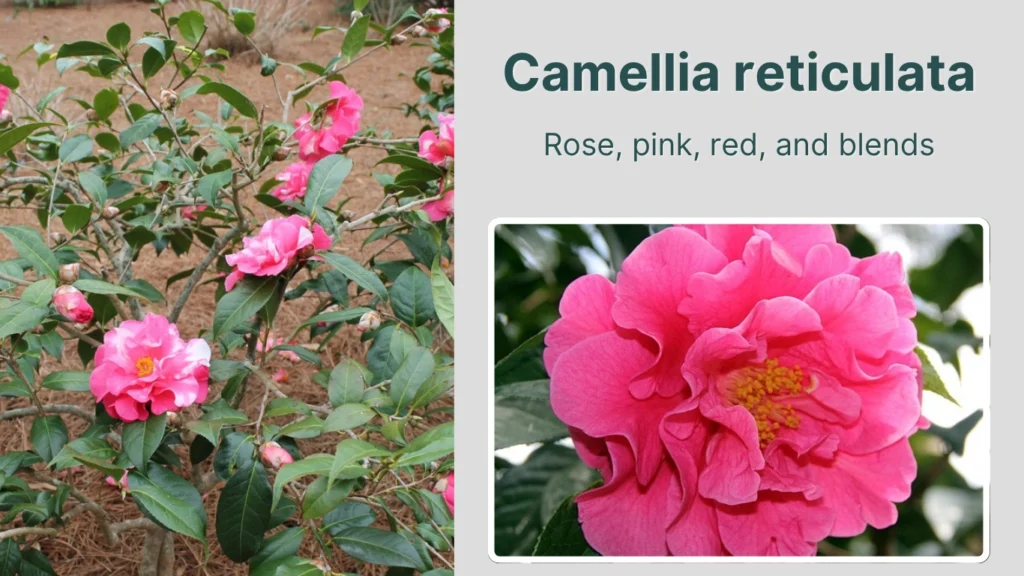
Camellia reticulata is known for its exceptionally large and showy flowers, often reaching 5 to 7 inches across. It has a more open, somewhat rangy growth habit and is often grown as a specimen shrub for its dramatic floral display.
Identification
- Flower Color: Rose, pink, red, and blends
- Bloom Form: Loose peony, semi-double, or anemone
- Leaf Type: Large, leathery, dull green leaves with deep veins
- Height: 8–15 feet
- Bloom Time: Late winter to mid-spring
- Type: Evergreen flowering shrub or small tree
Origin and Popularity
Native to Yunnan, China, Camellia reticulata is less cold-hardy but highly prized in camellia collections and specialty gardens for its large blossoms and unique petal structure.
Growing and Blooming Season
Plant in early spring or fall. Flowers appear from February to April. Best suited for USDA zones 8–10. Needs partial shade and rich, acidic, well-drained soil. More sensitive to cold than japonica or sasanqua types.
Companion Plants
Pairs well with hydrangeas, azaleas, and other acid-loving plants. Works beautifully as a standalone focal point in woodland gardens or large mixed shrub borders.
4. Camellia ‘Debutante’

Camellia ‘Debutante’ is a popular cultivar of Camellia japonica, admired for its large, fully double, soft pink blooms that resemble peonies. With its classic elegance and long bloom time, it’s a favorite for Southern gardens and formal landscapes.
Identification
- Flower Color: Light pink
- Bloom Form: Fully double, peony-style
- Leaf Type: Glossy, dark green, oval
- Height: 6–10 feet
- Bloom Time: Late winter to early spring
- Type: Camellia japonica cultivar
Origin and Popularity
Developed in the early 20th century in the United States, ‘Debutante’ quickly became a camellia garden staple for its soft, romantic appearance and reliable performance. It’s frequently used in traditional Southern landscaping.
Growing and Blooming Season
Plant in fall or spring. Blooms from January to March in mild climates. Grows best in USDA zones 7–9 in partial shade with acidic, well-drained soil. Prune lightly after blooming to maintain shape.
Companion Plants
Looks beautiful with azaleas, dogwoods, and ferns. Ideal for mixed borders, foundation plantings, or as a specimen shrub near patios and walkways.
5. Camellia ‘Pink Perfection’
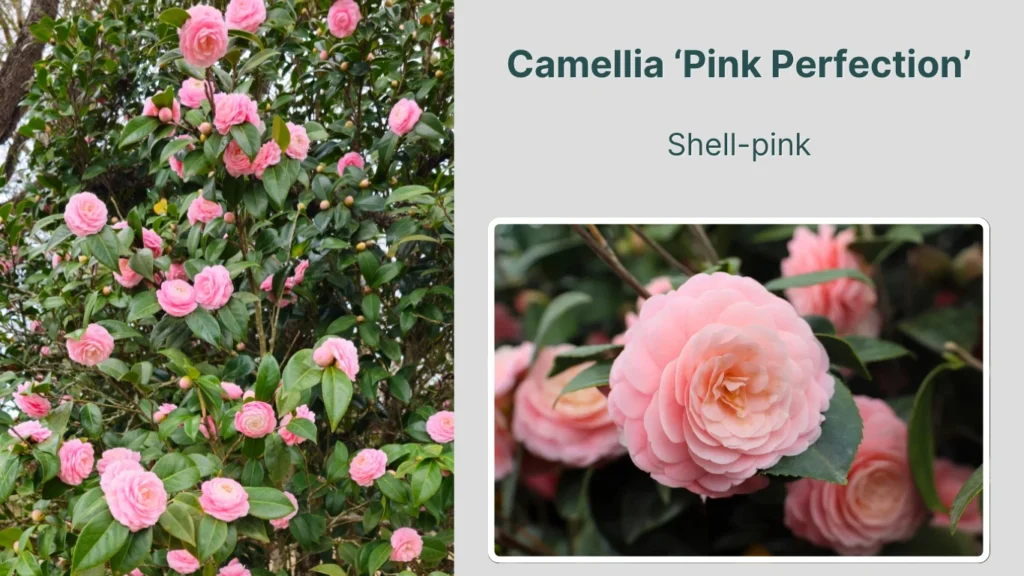
Camellia ‘Pink Perfection’ is a beloved heirloom variety, renowned for its perfectly symmetrical, formal double blooms in soft, shell-pink. It’s one of the most iconic Camellia japonica cultivars and offers a refined, classic look.
Identification
- Flower Color: Shell-pink
- Bloom Form: Formal double, rose-like
- Leaf Type: Glossy, medium-green, finely serrated
- Height: 6–12 feet
- Bloom Time: Late winter to mid-spring
- Type: Camellia japonica cultivar
Origin and Popularity
A Southern garden favorite since the 1800s, ‘Pink Perfection’ lives up to its name with blooms that are nearly flawless in symmetry. It is especially valued in historical gardens and formal plantings.
Growing and Blooming Season
Plant in early spring or fall. Begins blooming in late January or February and lasts into April. Best in USDA zones 7–9 in filtered sunlight and acidic, moist, well-drained soil.
Companion Plants
Pairs well with white flowering shrubs like gardenias or other pink shades like ‘Debutante’. Lovely in front yard landscapes, entry gardens, or around shaded patios.
6. Camellia ‘Nuccio’s Pearl’
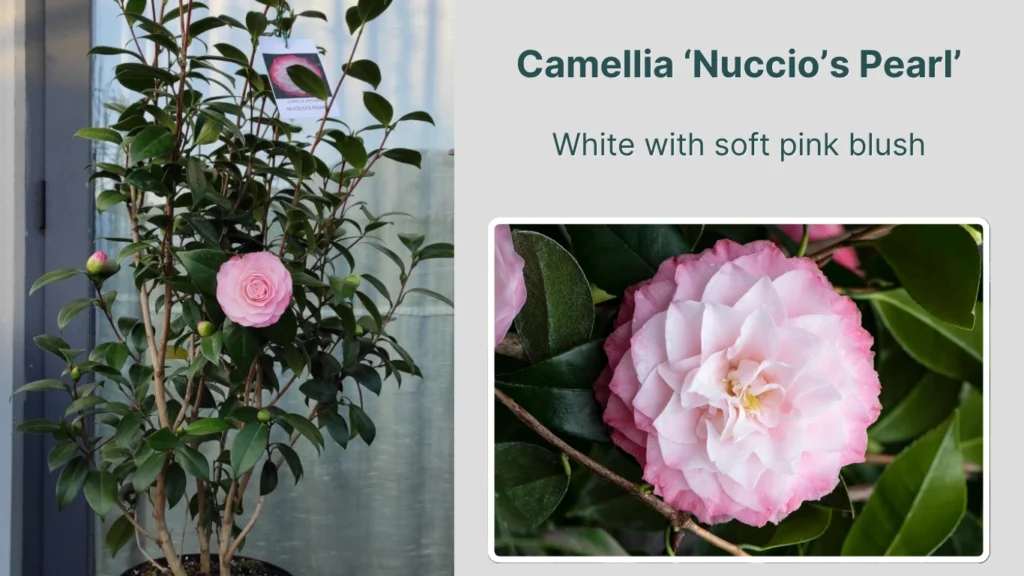
Camellia ‘Nuccio’s Pearl’ is a standout Camellia japonica cultivar known for its elegant, formal double blooms in pearly white with a soft blush of pink at the petal edges. It’s a refined and graceful plant perfect for brightening shaded garden areas.
Identification
- Flower Color: White with soft pink blush
- Bloom Form: Formal double
- Leaf Type: Glossy, deep green, oval
- Height: 6–10 feet
- Bloom Time: Mid to late winter into early spring
- Type: Camellia japonica cultivar
Origin and Popularity
Bred by the Nuccio family of California, one of the most respected camellia growers in the U.S., this variety is widely appreciated for its pure beauty and symmetry. It’s often featured in camellia shows and formal landscapes.
Growing and Blooming Season
Plant in fall or spring. Blooms from January to March. Best grown in USDA zones 8–10 with filtered sun or partial shade and well-drained, acidic soil. Protect blooms from frost for best results.
Companion Plants
Perfect with blue hydrangeas, boxwood, or ferns. A gorgeous specimen shrub or accent near patios, walkways, and woodland garden edges.
7. Camellia ‘Yuletide’
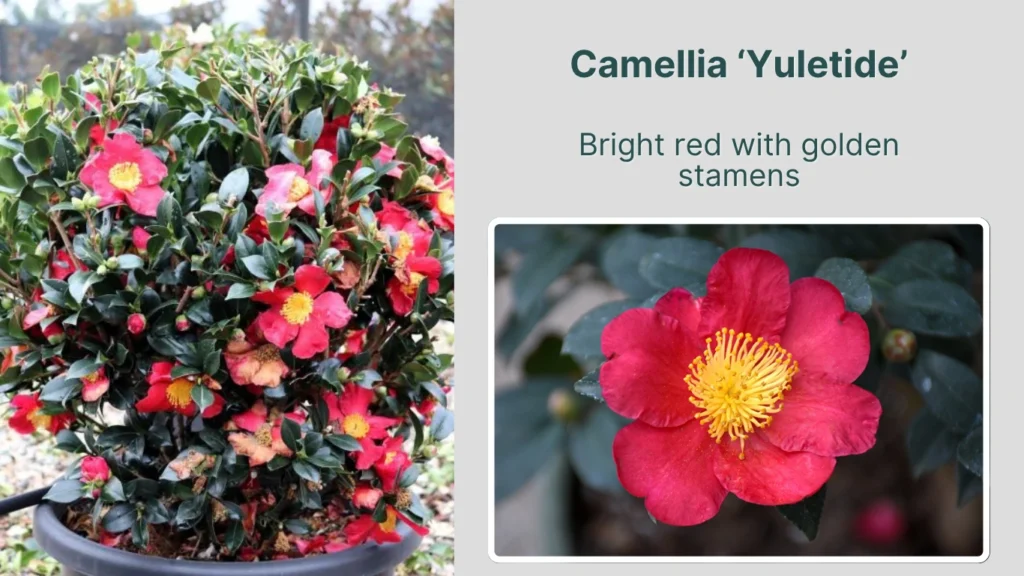
Camellia ‘Yuletide’ is a compact Camellia sasanqua cultivar that stands out for its bright red, single blooms and prominent golden stamens. Blooming during the holiday season, it brings welcome color to winter gardens and festive landscapes.
Identification
- Flower Color: Bright red with golden stamens
- Bloom Form: Single
- Leaf Type: Small, dark green, glossy
- Height: 5–8 feet
- Bloom Time: Late fall to early winter (around December)
- Type: Camellia sasanqua cultivar
Origin and Popularity
‘Yuletide’ is one of the most beloved winter-flowering camellias due to its timely blooming and vibrant color. It’s frequently used in holiday-themed gardens, containers, and foundation plantings.
Growing and Blooming Season
Plant in spring or fall. Blooms from November to January. Ideal for USDA zones 7–10. Grows well in full sun to part shade and thrives in acidic, well-drained soil.
Companion Plants
Excellent with evergreens, nandina, and ornamental grasses. Also pairs well with white pansies or violas for a festive seasonal display. Great for small gardens and decorative containers.
8. Camellia ‘April Tryst’
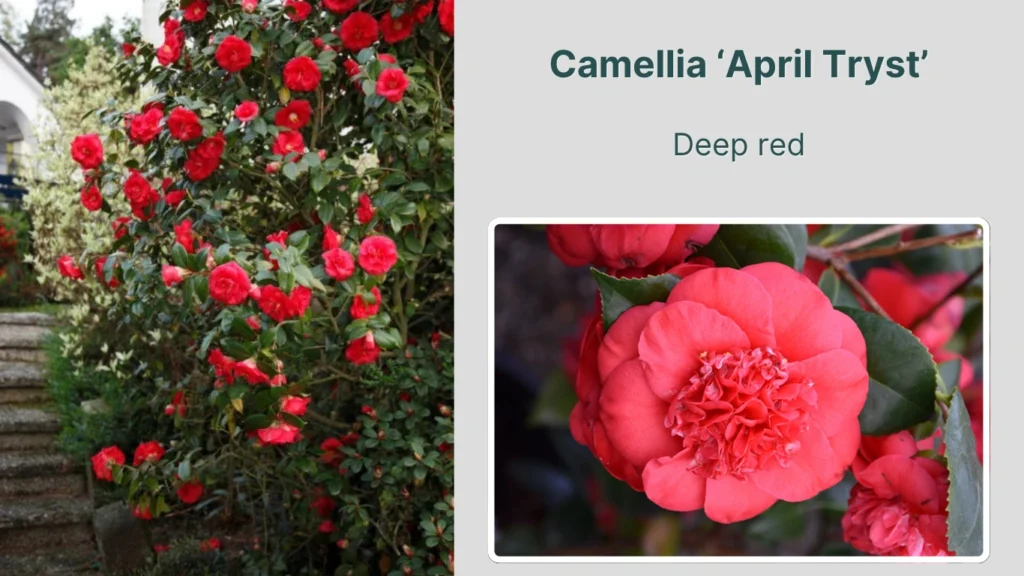
Camellia ‘April Tryst’ is a cold-hardy Camellia japonica hybrid that features bold, semi-double to peony-style red blooms. It’s specifically bred to withstand colder climates and bloom earlier than traditional japonicas.
Identification
- Flower Color: Deep red
- Bloom Form: Semi-double to peony-form
- Leaf Type: Dark green, leathery, and slightly serrated
- Height: 6–10 feet
- Bloom Time: Early to mid-spring
- Type: Cold-hardy japonica hybrid
Origin and Popularity
Part of the “April” series from Dr. William Ackerman, this variety was bred for colder USDA zones and extended bloom time. It’s a favorite for northern gardeners seeking classic camellia beauty with increased frost tolerance.
Growing and Blooming Season
Plant in fall or early spring. Begins blooming in March or April. Hardy in USDA zones 6–9. Prefers partial shade and acidic, well-drained soil. Very tolerant of frost compared to traditional japonicas.
Companion Plants
Great with hellebores, spring bulbs, and dwarf evergreens. Blends beautifully in woodland gardens or foundation plantings in colder regions.
9. Camellia ‘Chandleri Elegans’

Camellia ‘Chandleri Elegans’ is a heritage Camellia japonica cultivar famous for its rich rose-pink, anemone-form flowers with lighter petal edges. With origins dating back to the 19th century, it brings a sense of antique charm to any garden.
Identification
- Flower Color: Rose-pink with creamy center petaloids
- Bloom Form: Anemone-form
- Leaf Type: Glossy dark green, broad and dense
- Height: 8–12 feet
- Bloom Time: Late winter to mid-spring
- Type: Camellia japonica cultivar
Origin and Popularity
A British introduction from the 1800s, ‘Chandleri Elegans’ has stood the test of time and remains a beloved heirloom camellia in collections and classic garden designs.
Growing and Blooming Season
Plant in fall or spring. Blooms from February through April. Grows best in USDA zones 7–9 in part shade and acidic, well-drained soil. Its large blooms make it a standout feature plant.
Companion Plants
Pairs beautifully with rhododendrons, hostas, or white daffodils. Ideal for heritage gardens, formal borders, or shaded courtyard landscapes.
10. Camellia ‘Kramer’s Supreme’
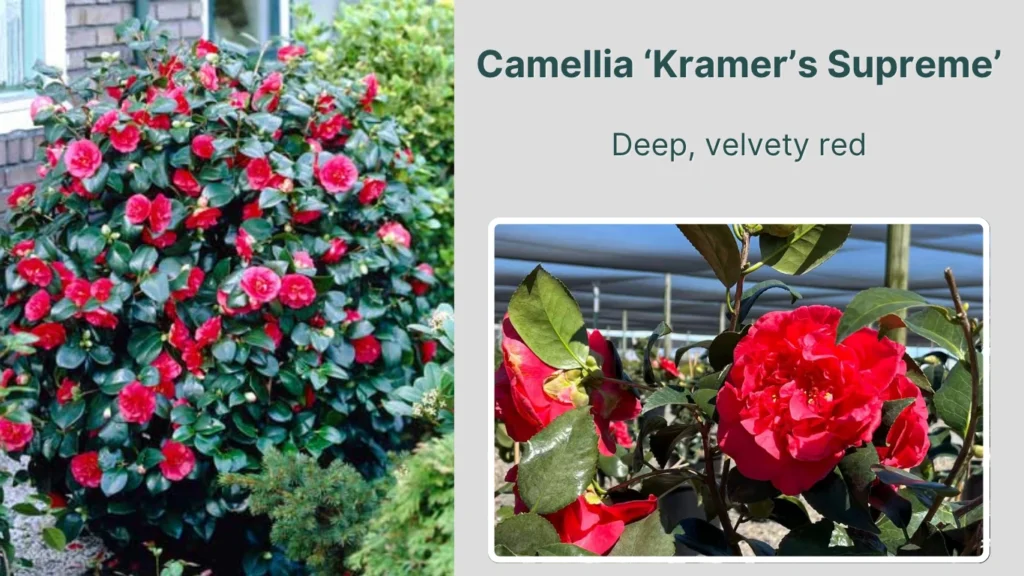
Camellia ‘Kramer’s Supreme’ is a striking Camellia japonica cultivar admired for its large, deep red, peony-style blooms with a rich, velvety texture. Its intense color and full form make it a standout specimen in shaded gardens.
Identification
- Flower Color: Deep, velvety red
- Bloom Form: Peony-form (dense, ruffled petals)
- Leaf Type: Glossy, dark green, oval and leathery
- Height: 6–10 feet
- Bloom Time: Late winter to early spring
- Type: Camellia japonica cultivar
Origin and Popularity
Introduced by Kramer Bros. Nursery, this variety quickly gained popularity for its vivid, show-quality blooms and excellent performance. It’s a favorite for cut flowers and garden impact.
Growing and Blooming Season
Plant in fall or early spring. Begins blooming around February through March. Best in USDA zones 7–9 with partial shade and rich, acidic, well-drained soil.
Companion Plants
Pairs beautifully with white camellias, ferns, or early spring bulbs like snowdrops. A great choice for formal borders, woodland gardens, or as a bold accent shrub.
11. Camellia ‘Black Magic’
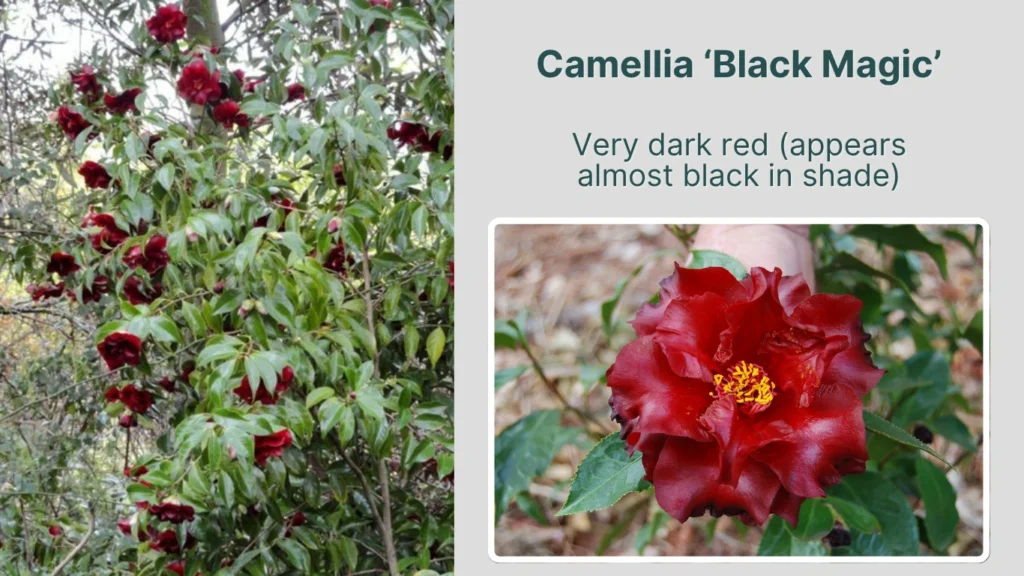
Camellia ‘Black Magic’ is a dramatic Camellia japonica cultivar featuring exceptionally dark red, nearly black, formal double blooms. Its glossy petals and compact habit make it a showstopper in shaded landscapes and container gardens.
Identification
- Flower Color: Very dark red (appears almost black in shade)
- Bloom Form: Formal double
- Leaf Type: Glossy, deep green, thick-textured
- Height: 6–8 feet
- Bloom Time: Late winter to early spring
- Type: Camellia japonica cultivar
Origin and Popularity
‘Black Magic’ is highly prized by collectors and gardeners seeking a bold, sophisticated look. Its unusually dark flowers have made it a standout in camellia shows and displays.
Growing and Blooming Season
Plant in early spring or fall. Blooms from January through March. Grows best in USDA zones 8–10 with partial shade and acidic, consistently moist soil.
Companion Plants
Striking when paired with white or blush-pink camellias, ornamental grasses, or silver-leafed plants like artemisia. Ideal for creating moody garden corners or elegant, color-contrasted plantings.
12. Camellia ‘Spring’s Promise’
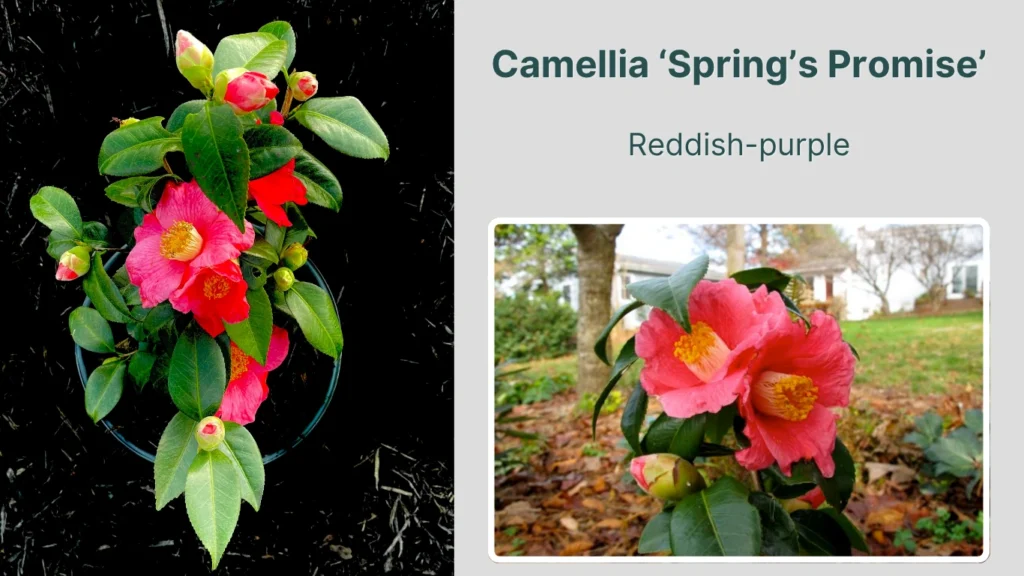
Camellia ‘Spring’s Promise’ is a cold-hardy Camellia japonica hybrid developed for early blooming in cooler climates. It features rich reddish-purple, semi-double blooms and a compact, upright growth habit.
Identification
- Flower Color: Reddish-purple
- Bloom Form: Semi-double
- Leaf Type: Glossy, dark green, finely serrated
- Height: 5–8 feet
- Bloom Time: Late winter to early spring
- Type: Cold-hardy hybrid camellia
Origin and Popularity
Part of Dr. William Ackerman’s cold-hardy series, ‘Spring’s Promise’ was bred to thrive in USDA zones as low as 6. It’s a top pick for gardeners in colder areas who want traditional camellia beauty without winter damage.
Growing and Blooming Season
Plant in spring or fall. Begins blooming as early as February. Hardy in USDA zones 6–9. Requires part shade and acidic, well-drained soil. Benefits from winter mulch protection in colder areas.
Companion Plants
Looks lovely with snowdrops, hellebores, and deciduous ferns. A reliable option for cold-zone camellia enthusiasts, woodland borders, and sheltered entryways.
13. Camellia ‘White by the Gate’

Camellia ‘White by the Gate’ is a refined and formal Camellia japonica variety, renowned for its pure white, rose-like double blooms. It brings classic charm and a serene color palette to shaded gardens and elegant landscapes.
Identification
- Flower Color: Pure white
- Bloom Form: Formal double
- Leaf Type: Glossy, medium to dark green, oval
- Height: 6–10 feet
- Bloom Time: Late winter to early spring
- Type: Camellia japonica cultivar
Origin and Popularity
This elegant cultivar is a favorite for southern gardens and formal settings, often used in bridal-themed plantings or serene white gardens. Its refined appearance makes it a timeless classic.
Growing and Blooming Season
Plant in fall or spring. Blooms from February to March. Best in USDA zones 7–9 in dappled shade and acidic, well-drained soil. Flowers benefit from frost protection in colder regions.
Companion Plants
Pairs beautifully with boxwood, gardenias, and snowdrops. Its crisp white blooms also contrast well with red or pink camellias, making it ideal for mixed camellia displays or monochrome white gardens.
14. Camellia ‘Lady Vansittart’

Camellia ‘Lady Vansittart’ is a unique and eye-catching Camellia japonica cultivar known for its semi-double blooms that often display striking variegation—pink petals with irregular white streaks and splashes.
Identification
- Flower Color: Pink with white stripes or blotches (highly variegated)
- Bloom Form: Semi-double
- Leaf Type: Glossy, dark green, thick and slightly serrated
- Height: 8–12 feet
- Bloom Time: Late winter to early spring
- Type: Camellia japonica cultivar
Origin and Popularity
Originating in the 1800s, ‘Lady Vansittart’ is one of the oldest and most distinctive variegated camellias. Its unpredictable and bold coloring makes it a standout in any garden.
Growing and Blooming Season
Plant in fall or early spring. Blooms from February through April. Ideal for USDA zones 7–9. Requires partial shade and acidic, well-drained soil. Protect buds from frost for the best display.
Companion Plants
Excellent with solid-colored camellias like ‘White by the Gate’ or ‘Kramer’s Supreme’. Also pairs well with shade-loving perennials like hellebores and Japanese anemones.
15. Camellia ‘Bob Hope’

Camellia ‘Bob Hope’ is a bold Camellia japonica hybrid celebrated for its large, velvety red, semi-double blooms and its strong, upright growth. Named in honor of the American entertainer, it delivers star-quality color in winter gardens.
Identification
- Flower Color: Deep red
- Bloom Form: Semi-double
- Leaf Type: Dark green, glossy, oval
- Height: 6–10 feet
- Bloom Time: Late winter to early spring
- Type: Camellia japonica hybrid
Origin and Popularity
Bred for rich color and consistent form, ‘Bob Hope’ is frequently featured in camellia competitions and admired for its striking presence in the landscape.
Growing and Blooming Season
Plant in spring or fall. Flowers from January to March. Suitable for USDA zones 7–9. Prefers partial shade, acidic soil, and consistent moisture without soggy conditions.
Companion Plants
Pairs beautifully with white- or blush-flowered camellias, ferns, and azaleas. Makes a striking focal point in shaded garden beds or near entryways.
16. Camellia ‘Setsugekka’

Camellia ‘Setsugekka’ is a classic Camellia sasanqua variety known for its large, elegant white flowers with ruffled petals and bright golden stamens. Its name translates to “Snow, Moon, Flowers,” reflecting its graceful and seasonal beauty.
Identification
- Flower Color: Pure white with yellow stamens
- Bloom Form: Semi-double to ruffled single
- Leaf Type: Small, glossy, dark green, oval
- Height: 8–10 feet
- Bloom Time: Fall to early winter
- Type: Camellia sasanqua cultivar
Origin and Popularity
Originating in Japan, ‘Setsugekka’ has long been admired for its refined appearance and early blooming season. It’s popular in both formal and naturalistic gardens for hedging, screening, and espalier.
Growing and Blooming Season
Plant in fall or early spring. Blooms from October to December. Performs best in USDA zones 7–10. Tolerates more sun than most camellias and prefers slightly acidic, well-drained soil.
Companion Plants
Pairs well with nandina, ornamental grasses, or pansies in seasonal plantings. Its white blooms stand out beautifully against dark foliage and evergreen backdrops.
17. Camellia ‘Mathotiana’

Camellia ‘Mathotiana’ is a richly colored Camellia japonica cultivar prized for its large, formal double, deep crimson flowers that resemble velvet roses. It’s a showpiece plant with classic Southern charm.
Identification
- Flower Color: Deep crimson or rose-red
- Bloom Form: Formal double
- Leaf Type: Thick, dark green, oval with fine serration
- Height: 8–12 feet
- Bloom Time: Late winter to mid-spring
- Type: Camellia japonica cultivar
Origin and Popularity
Introduced in Europe in the 19th century, ‘Mathotiana’ remains one of the most admired red camellias worldwide. It is a popular choice in historic gardens and camellia collections for its luxurious flower form and vivid color.
Growing and Blooming Season
Plant in spring or fall. Flowers from February through April. Hardy in USDA zones 7–9. Prefers partial shade and rich, acidic, well-drained soil.
Companion Plants
Excellent alongside camellias like ‘Pink Perfection’ or white-flowered varieties. Works beautifully in formal garden designs, woodland borders, or large containers.
18. Camellia ‘Donation’

Camellia ‘Donation’ is a vigorous Camellia x williamsii hybrid known for its abundant, semi-double to peony-form blooms in a rich rose-pink hue. Its graceful form, long blooming season, and cold tolerance make it a standout in temperate gardens.
Identification
- Flower Color: Rose-pink
- Bloom Form: Semi-double to peony-form
- Leaf Type: Glossy, dark green, elliptic
- Height: 8–12 feet
- Bloom Time: Late winter to mid-spring
- Type: Camellia x williamsii hybrid
Origin and Popularity
Bred in the U.K., ‘Donation’ is a cross between Camellia saluenensis and Camellia japonica. It’s renowned for blooming profusely, even in less-than-ideal weather, and is a favorite in European camellia gardens.
Growing and Blooming Season
Plant in fall or spring. Blooms from February through April. Hardy in USDA zones 7–9. Tolerates more sun and wind than many japonicas and performs well in acidic, well-drained soil.
Companion Plants
Lovely with hellebores, early spring bulbs, or companion camellias like ‘Spring’s Promise’. Makes an excellent hedge, specimen shrub, or background plant in a mixed border.
19. Camellia ‘High Fragrance’

Camellia ‘High Fragrance’ is a rare camellia cultivar celebrated not only for its soft pink, peony-like flowers but also for its unusually strong and pleasant fragrance—something uncommon in camellias.
Identification
- Flower Color: Pale pink to blush
- Bloom Form: Loose peony to semi-double
- Leaf Type: Medium green, slightly leathery
- Height: 6–10 feet
- Bloom Time: Late winter to early spring
- Type: Fragrant hybrid camellia
Origin and Popularity
A hybrid of Camellia japonica and Camellia lutchuensis, ‘High Fragrance’ was bred specifically for scent and beauty. It’s a collector’s favorite and often grown near walkways or entryways where the fragrance can be appreciated.
Growing and Blooming Season
Plant in early spring or fall. Blooms from February to March. Suitable for USDA zones 8–10. Prefers part shade, shelter from strong wind, and acidic, well-drained soil.
Companion Plants
Ideal with gardenias, daphne, or other scented shrubs. Its pale pink tones also complement white or burgundy camellias in fragrance-focused garden spaces or courtyard plantings.
20. Camellia ‘Jean May’

Camellia ‘Jean May’ is a delicate and graceful Camellia sasanqua cultivar, known for its soft shell-pink semi-double blooms with ruffled petals and golden stamens. Its compact habit and extended bloom time make it perfect for borders and foundation plantings.
Identification
- Flower Color: Light shell pink
- Bloom Form: Semi-double with ruffled petals
- Leaf Type: Small, glossy, dark green
- Height: 6–8 feet
- Bloom Time: Fall to early winter
- Type: Camellia sasanqua cultivar
Origin and Popularity
A Southern garden favorite, ‘Jean May’ offers gentle color and early-season flowers. It’s popular for adding beauty to small gardens or patio areas, especially during the cooler months.
Growing and Blooming Season
Plant in spring or fall. Blooms from October to December. Hardy in USDA zones 7–10. Prefers partial sun to light shade and well-drained, slightly acidic soil.
Companion Plants
Pairs beautifully with dwarf azaleas, violas, and ornamental grasses. Works well in cottage gardens, foundation beds, or espaliered against walls for soft seasonal color.
21. Camellia ‘Royal Velvet’

Camellia ‘Royal Velvet’ is a striking Camellia japonica cultivar known for its deep red, velvety formal double blooms that have a regal presence. It produces one of the darkest red flowers among camellias, making it ideal for dramatic garden displays.
Identification
- Flower Color: Dark velvety red
- Bloom Form: Formal double
- Leaf Type: Thick, glossy, dark green
- Height: 6–10 feet
- Bloom Time: Late winter to mid-spring
- Type: Camellia japonica cultivar
Origin and Popularity
‘Royal Velvet’ is a sought-after variety for camellia shows and collectors due to its intense color and clean bloom form. It’s also popular in landscapes for those seeking bold color and refined structure.
Growing and Blooming Season
Plant in early spring or fall. Blooms from February to April. Best in USDA zones 7–9 in partial shade and acidic, moist, but well-drained soil.
Companion Plants
Striking when planted with silver-leaved plants, ferns, or white camellias like ‘White by the Gate’. A dramatic focal shrub in formal gardens or mixed shaded borders.
22. Camellia ‘Adolphe Audusson’

Camellia ‘Adolphe Audusson’ is a classic Camellia japonica cultivar featuring large, semi-double, deep crimson-red blooms with prominent golden stamens. It’s known for its vigorous growth and stunning floral contrast.
Identification
- Flower Color: Deep crimson with yellow stamens
- Bloom Form: Semi-double
- Leaf Type: Glossy, broad, dark green
- Height: 8–12 feet
- Bloom Time: Late winter to mid-spring
- Type: Camellia japonica cultivar
Origin and Popularity
Originating in France in the 19th century, ‘Adolphe Audusson’ has remained a favorite across Europe and the U.S. for its dramatic appearance and reliable performance. It’s widely grown in historical gardens.
Growing and Blooming Season
Plant in spring or fall. Blooms from February to April. Best in USDA zones 7–9. Prefers partial shade, rich acidic soil, and good air circulation.
Companion Plants
Ideal with soft-colored azaleas, hellebores, or white daffodils. Its vivid red blooms make it an excellent choice for garden accents and camellia walkways.
23. Camellia ‘Egao Corkscrew’

Camellia ‘Egao Corkscrew’ is a unique and ornamental variety of Camellia japonica grown for both its soft pink flowers and its twisting, spiraled branches—making it a favorite for bonsai, container growing, and artistic landscaping.
Identification
- Flower Color: Soft pink
- Bloom Form: Semi-double to loose peony
- Leaf Type: Small, glossy, dark green
- Height: 6–8 feet (or smaller in containers)
- Bloom Time: Late winter to early spring
- Type: Twisted-branch Camellia japonica cultivar
Origin and Popularity
Originally from Japan, ‘Egao Corkscrew’ is especially prized for its architectural form. Its contorted branches add winter interest even when not in bloom, making it perfect for focal plantings or bonsai use.
Growing and Blooming Season
Plant in fall or spring. Blooms from February to March. Suitable for USDA zones 7–9. Requires acidic, well-drained soil and dappled shade. Best pruned to showcase its unique shape.
Companion Plants
Excellent with ornamental mosses, compact ferns, and shade-loving groundcovers. Great in Zen-inspired gardens, small spaces, or displayed as a living sculpture.
24. Camellia ‘Night Rider’

Camellia ‘Night Rider’ is a striking and unusual hybrid camellia, known for its deep maroon to near-black, small single flowers. Its unique coloring and compact size make it a favorite among collectors and dark-flower enthusiasts.
Identification
- Flower Color: Dark maroon to nearly black
- Bloom Form: Single
- Leaf Type: Small, dark green, slightly pointed
- Height: 4–6 feet
- Bloom Time: Early to mid-spring
- Type: Hybrid camellia (C. japonica × C. saluenensis)
Origin and Popularity
Developed in New Zealand, ‘Night Rider’ stands out as one of the darkest-flowered camellias available. Its rarity and ornamental value make it a prized specimen in modern camellia collections.
Growing and Blooming Season
Plant in spring or fall. Blooms in March and April. Best grown in USDA zones 8–10 with partial shade and moist, acidic, well-drained soil.
Companion Plants
Pairs dramatically with silver foliage plants, pale-pink camellias, or contrasting white-blooming shrubs. Works beautifully in modern gardens, containers, or as a standout accent in small spaces.
25. Camellia ‘Betty Sheffield’

Camellia ‘Betty Sheffield’ is a charming and highly variable Camellia japonica cultivar, featuring semi-double flowers that often display pink, white, or variegated petals—sometimes all on the same plant.
Identification
- Flower Color: White with pink edges or fully variegated pink and white
- Bloom Form: Semi-double to irregular peony
- Leaf Type: Glossy, deep green, rounded
- Height: 6–10 feet
- Bloom Time: Late winter to early spring
- Type: Camellia japonica cultivar
Origin and Popularity
Discovered in the southeastern U.S. in the 1940s, ‘Betty Sheffield’ is loved for its unpredictably beautiful blooms. It has inspired several sports (natural variants), making it a conversation piece in any garden.
Growing and Blooming Season
Plant in fall or early spring. Blooms from February to March. Ideal for USDA zones 7–9 in partial shade and acidic, well-drained soil.
Companion Plants
Stunning with soft pink azaleas, spring bulbs, or other white and red camellias. Its ever-changing flowers make it perfect for informal borders or artistic plant groupings.






